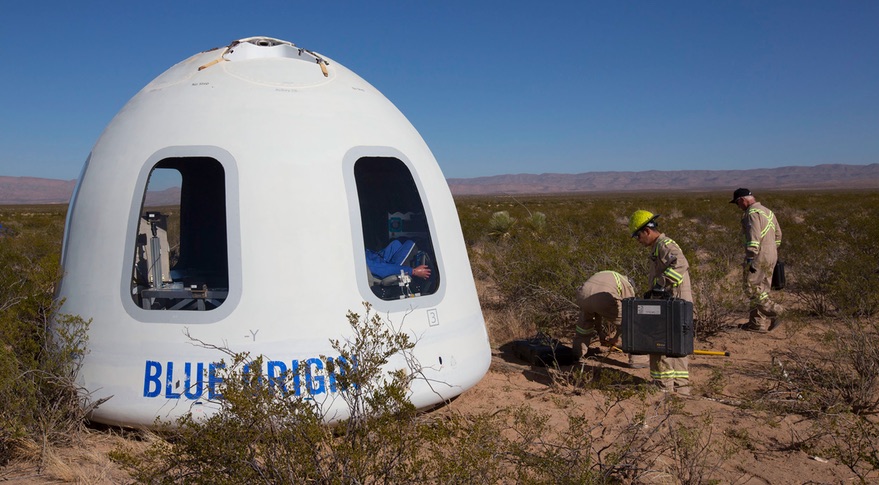
NASA to allow researchers to fly on commercial suborbital vehicles
by Jeff FoustWASHINGTON — NASA plans for the first time to allow researchers to fly with their payloads on commercial suborbital vehicles, ending years of debate and deliberation.
NASA released Jan. 29 a draft solicitation seeking payloads for its Flight Opportunities program, which provides rides for such payloads on high-altitude balloons, parabolic aircraft flights and commercial suborbital vehicles. That includes reusable suborbital spacecraft currently being flight tested by Blue Origin and Virgin Galactic.
In the past, researchers could propose flying payloads on Blue Origin’s New Shepard or Virgin Galactic’s SpaceShipTwo, but the payloads had to be automated. In the draft solicitation, researchers can, for the first time, propose flying with their payloads on those vehicles.
“Human spaceflight participants on these missions is increasingly viable and being demonstrated,” said Jim Reuter, NASA associate administrator for space technology, in a Jan. 29 talk at the 23rd Annual Commercial Space Transportation Conference here announcing plans to allow researchers to fly with their payloads.
According to the draft solicitation, research payloads, regardless of vehicle, would have to fit into two categories. One is for research linked to NASA’s lunar exploration plans and supporting commercial activity beyond Earth orbit. The other is for research linked to commercial suborbital applications and commercialization of low Earth orbit. Researchers can seek up to $650,000 for projects in the first category and $450,000 for those in the other category.
Those researchers seeking to fly with their payloads would have to accept the “informed consent” provisions in current federal law about commercial suborbital spaceflight, where those flying on such vehicles acknowledge that such vehicles have not been certified as safe by the Federal Aviation Administration. “NASA holds no safety responsibility for suborbital flights conducted under this solicitation,” the draft solicitation states.
The draft also requires the vehicles have a track record of flights. The solicitation states that, for those with spaceflight participants on board, there can be no more than one launch or reentry accident in the last 14 flights of that particular vehicle design.
The idea of allowing researchers to fly with their payloads is not new. “We’ve been trying to work pretty hard with this community, so it hopefully isn’t, to those that are keenly interested in this in this community, not a big surprise,” Reuter said.
In 2013, Lori Garver, at the time NASA deputy administrator, announced at a suborbital research conference that the agency would lift prohibitions on people flying with their payloads. However, NASA delayed implementing that plan for years, in part because Garver left NASA shortly after her announcement and also because of delays in the development of commercial suborbital crewed vehicles.
Reuter’s predecessor as associate administrator for space technology, Steve Jurczyk, reopened the door for flying researchers on suborbital vehicles in late 2017 at another suborbital research conference. He said then that NASA would consider applying the same approaches to suborbital vehicles as it does for parabolic aircraft flights, where the agency has long allowed researchers to fly with their payloads.
Neither Blue Origin nor Virgin Galactic are flying people commercially, be they researchers or tourists, but expect to do in the near future. Virgin Galactic has previously stated it plans to start commercial flights by this summer, after a final series of test flights of its SpaceShipTwo vehicle at Spaceport America in New Mexico.
“We are looking forward to flying humans this year,” said Clay Mowry, vice president for global sales, marketing and customer experience at Blue Origin, during a Jan. 29 panel discussion at the commercial space transportation conference. “We think we’re on track. We’ve got a couple of test flights ahead of us here, but we are excited about the opportunity to fly humans this year.”
Other government agencies outside the United States have already announced plans to fly researchers on suborbital vehicles. In October, the Italian Air Force signed an agreement with Virgin Galactic for a dedicated SpaceShipTwo research flight that will also include three people.
The NASA Flight Opportunities announcement was welcomed by advocates for suborbital research. “We thought for a long time that NASA should adopt this,” said Alan Stern, vice president of the space science and engineering division of the Southwest Research Institute, during a Jan. 30 talk at the conference. “I couldn’t be more excited.”
Stern said that having researchers fly with their payloads eliminates the need to automate them, which in turn can make those payloads less expensive and more reliable. Regarding the risks of such flights, he noted that scientists in many fields are used to working in extreme and dangerous conditions.
NASA is seeking comments on the draft solicitation through Feb. 14, and expects to release a final version by the end of the month. “I expect that researchers will be selected by NASA to fly on spaceflights with their experiments before the year is out,” Stern predicted.